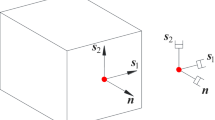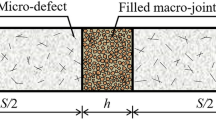Abstract
The three-dimensional explicit discontinuous deformation analysis (3D-EDDA), namely the deformable distinct element method (3D-DDEM), is first applied to analyze the dynamic response of rock masses subject to wave incidence. Three existing viscous boundaries derived using the principle of minimum potential energy in DDA are reformulated with the virtual work principle, which firstly reveal that their major differences lie in the choice of maximum, average, and Newmark (ending) velocity for each time step. The force input method through a viscous boundary is integrated into EDDA/DDEM to simulate the infinite domain on the incidence side. Moreover, the impact of artificial joints on step size and absorbing efficiency is evaluated. A novel index, artificial joint ratio (AJR), is then applied to remedy the viscous boundary and achieves the expected improvement. Detailed numerical cases are performed, which cover the simulation of wave propagation in continuous, spalling, and fractured models. The desirable results warrant further investigation of EDDA/DDEM.
Highlights
-
1.
Three viscous boundaries used in DDA are reformulated and compared.
-
2.
Viscous boundaries are firstly applied and validated in 3D-EDDA/DDEM.
-
3.
Influence of artificial joints on time step size and viscous boundary is quantified.
-
4.
Wave propagation in continuous, spalling, and fractured rock masses is explored.















Similar content being viewed by others
References
Bao H, Zhao Z (2010) An alternative scheme for the corner-corner contact in the two-dimensional Discontinuous Deformation Analysis. Adv Eng Softw 41:206–212. https://doi.org/10.1016/j.advengsoft.2009.09.007
Bao H, Hatzor YH, Huang X (2012) A new viscous boundary condition in the two-dimensional discontinuous deformation analysis method for wave propagation problems. Rock Mech Rock Eng 45:919–928. https://doi.org/10.1007/s00603-012-0245-y
Cundall PA (1988) Formulation of a three-dimensional distinct element model—Part I. A scheme to detect and represent contacts in a system composed of many polyhedral blocks. Int J Rock Mech Min Sci Geomech Abstr 25:107–116
Cundall PA, Strack ODL (1979) A discrete numerical model for granular assemblies. Géotechnique 29:47–65. https://doi.org/10.1680/geot.1979.29.1.47
Dosta M, Costa C, Al-Qureshi H (2017) Numerical investigation of compaction of deformable particles with bonded-particle model. In: EPJ Web of Conferences. EDP Sciences, p. 15021
Fan H, He S (2015) An angle-based method dealing with vertex-vertex contact in the two-dimensional discontinuous deformation analysis (DDA). Rock Mech Rock Eng 48:2031–2043. https://doi.org/10.1007/s00603-014-0692-8
Fu X, Sheng Q, Zhang Y, Chen J (2015a) Application of the discontinuous deformation analysis method to stress wave propagation through a one-dimensional rock mass. Int J Rock Mech Min Sci 80:155–170
Fu X, Sheng Q, Zhang Y, Zhou Y, Dai F (2015b) Boundary setting method for the seismic dynamic response analysis of engineering rock mass structures using the discontinuous deformation analysis method. Int J Numer Anal Methods Geomech 39:1693–1712
Fu X, Sheng Q, Zhang Y, Chen J, Leng X (2016) Extension of the discontinuous deformation analysis method to simulate seismic response of a large rock cavern complex. Int J Geomech 17(5): E4016008
Fu X, Sheng Q, Zhang Y, Chen J (2017) Time-frequency analysis of seismic wave propagation across a rock mass using the discontinuous deformation analysis method. Int J Geomech ASCE 17:1–15. https://doi.org/10.1061/(ASCE)GM.1943-5622.0000892
Gong W, Wang Y, Ning Y, Luo Y, Wang Y (2017) Validating the ability of the discontinuous deformation analysis method to model normal P-wave propagation across rock fractures. Int J Numer Anal Methods Geomech 41:1267–1282. https://doi.org/10.1002/nag.2679
Goodman RE (1976) Methods of geological engineering in discontinuous rocks. West Group
Hart R, Cundall PA, Lemos J (1988) Formulation of a three-dimensional distinct element model—Part II. Mechanical calculations for motion and interaction of a system composed of many polyhedral blocks. In: International Journal of Rock Mechanics and Mining Sciences & Geomechanics Abstracts. Elsevier, pp 117–125
Hatzor YH, Ma G, Shi G (2017) Discontinuous deformation analysis in rock mechanics practice. CRC Press
Jiao YY, Zhang XL, Zhao J, Liu QS (2007) Viscous boundary of DDA for modeling stress wave propagation in jointed rock. Int J Rock Mech Min Sci 44:1070–1076. https://doi.org/10.1016/j.ijrmms.2007.03.001
Jiong Gu, Zhiye Z (2009) Considerations of the discontinuous deformation analysis on wave propagation problems. Int J Numer Anal Methods Geomech 33:1449–1465
Kuhlemeyer RL, Lysmer J (1973) Finite element method accuracy for wave propagation problems. J Soil Mech Found Div 99:421–427
Liao ZP (2002) Introduction to wave motion theories in engineering. [M] Sci Bei**g 136–285 (in Chinese)
Lin Y, Zong Z, Tian S, Lin J (2018) A new baseline correction method for near-fault strong-motion records based on the target final displacement. Soil Dyn Earthq Eng 114:27–37
Mikola RG, Sitar N (2013) Explicit three dimensional discontinuous deformation analysis for blocky system. In: 47th US Rock Mech. / Geomech. Symp. 2013 2, 1320–1327
Munjiza AA (2004) The combined finite-discrete element method. John Wiley & Sons
Munjiza A, Owen DRJ, Bicanic N (1995) A combined finite‐discrete element method in transient dynamics of fracturing solids. Eng Comput
Nezamabadi S, Nguyen TH, Delenne J-Y, Radjai F (2017) Modeling soft granular materials. Granul Matter 19:1–12
Ning YJ, Zhao ZY, Sun JP, Yuan WF (2012) Using the discontinuous deformation analysis to model wave propagations in jointed rock masses. C-Comput Model Eng Sci 89:221-262
Otsubo M, O’Sullivan C, Shire T (2017) Empirical assessment of the critical time increment in explicit particulate discrete element method simulations. Comput Geotech 86:67–79
Peng X, Yu P, Zhang Y, Chen G (2018) Applying modified discontinuous deformation analysis to assess the dynamic response of sites containing discontinuities. Eng Geol 246:349–360. https://doi.org/10.1016/J.ENGGEO.2018.10.011
Peng X, Yu P, Chen G, **a M, Zhang Y (2020) CPU-accelerated explicit discontinuous deformation analysis and its application to landslide analysis. Appl Math Model 77:216–234
Reddy JN (2017) Energy principles and variational methods in applied mechanics. John Wiley & Sons
Shi G (1992) Discontinuous deformation analysis: a new numerical model for the statics and dynamics of deformable block structures. Eng Comput
Shi GH (2015) Contact theory. Sci China Technol Sci 58:1450–1496. https://doi.org/10.1007/s11431-015-5814-3
Song Y, Huang D, Zeng B (2017) GPU-based parallel computation for discontinuous deformation analysis (DDA) method and its application to modelling earthquake-induced landslide. Comput Geotech 86:80–94. https://doi.org/10.1016/j.compgeo.2017.01.001
Wang X, Wu W, Zhu H, Lin J-S, Zhang H (2019) Contact detection between polygonal blocks based on a novel multi-cover system for discontinuous deformation analysis. Comput Geotech 111:56–65. https://doi.org/10.1016/j.compgeo.2019.03.004
Wang X, Wu W, Zhu H, Lin J-S, Zhang H (2020a) Acceleration of contact detection between arbitrarily shaped polyhedra based on multi-cover methods in three dimensional discontinuous deformation analysis. Int J Rock Mech Min Sci 132:104387. https://doi.org/10.1016/j.ijrmms.2020.104387
Wang X, Wu W, Zhu H, Zhang H, Lin J-S (2020b) The last entrance plane method for contact indeterminacy between convex polyhedral blocks. Comput Geotech 117:103283
Wang X, Wu W, Zhu H, Liu F, Zhang H, Lin J-S (2021) Three-dimensional discontinuous deformation analysis with explicit contact formulation and block-wise multicore CPU acceleration. Comput Geotech 139:104410
Wang X, Wu W, Zhu H, Zhang H (2022a) Three-dimensional discontinuous deformation analysis derived from the virtual work principle with a simplex integral on the boundary. Comput Geotech 146:104710
Wang X, Wu W, Zhu H, Zhang H, Lin J-S (2022b) Three-dimensional deformable distinct element method with polyhedral elements and cloud GPGPU acceleration. Comput Geotech 146:104732
Wu W, Zhu H, Zhuang X, Ma G, Cai Y (2014) A multi-shell cover algorithm for contact detection in the three dimensional discontinuous deformation analysis. Theor Appl Fract Mech 72:136–149. https://doi.org/10.1016/j.tafmec.2014.03.004
Wu W, Wang X, Zhu H, Shou K-J, Lin J-S, Zhang H (2020) Improvements in DDA program for rockslides with local in-circle contact method and modified open-close iteration. Eng Geol 265:105433
Wu W, Wang X, Zhu H, Zhang H, Lin J-S, Bobet A (2021) Improved friction force calculation with an augmented open-close iteration formulation in discontinuous deformation analysis. Comput Geotech 130:103932
**a M, Chen G, Guo L (2021) Improvement of vertex-to-vertex contact processing in two-dimensional DDA. Comput Geotech 135:104200
**ao Y, Huang M, Miao Q, **ao J, Wang Y (2017) Architecting the discontinuous deformation analysis method pipeline on the GPU. Proc. - 2017 IEEE 31st Int. Parallel Distrib Process Symp Work IPDPSW 2017:1188–1197. https://doi.org/10.1109/IPDPSW.2017.93
Yan C, Jiao Y-Y, Zheng H (2018) A fully coupled three-dimensional hydro-mechanical finite discrete element approach with real porous seepage for simulating 3D hydraulic fracturing. Comput Geotech 96:73–89
Yang Y, Xu D, Zheng H (2018) Explicit discontinuous deformation analysis method with lumped mass matrix for highly discrete block system. Int J Geomech 18:4018098
Yang Y, Xu D, Zheng H, Wu Z, Huang D (2021) Modeling wave propagation in rock masses using the contact potential-based three-dimensional discontinuous deformation analysis method. Rock Mech Rock Eng. https://doi.org/10.1007/s00603-020-02359-x
Zhang QB, Zhao J (2014) A review of dynamic experimental techniques and mechanical behaviour of rock materials. Rock Mech Rock Eng 47:1411–1478
Zhang YH, Fu XD, Sheng Q, Leng XL (2013) Study on elastic P-wave propagation law in unfavorable geologic structures with discontinuous deformation analysis method. Arab J Geosci 6:4557–4564
Zhang Y, Fu X, Sheng Q (2014) Modification of the discontinuous deformation analysis method and its application to seismic response analysis of large underground caverns. Tunn Undergr Sp Technol 40:241–250
Zhang H, Chen G, Zheng L, Han Z, Zhang Y, Wu YQ, Liu S (2015) Detection of contacts between three-dimensional polyhedral blocks for discontinuous deformation analysis. Int J Rock Mech Min Sci 78:57–73. https://doi.org/10.1016/j.ijrmms.2015.05.008
Zhang H, Liu S, Zheng L, Zhu H, Zhuang X, Zhang Y, Wu Y (2018a) Method for resolving contact indeterminacy in three-dimensional discontinuous deformation analysis. Int J Geomech 18:04018130. https://doi.org/10.1061/(ASCE)GM.1943-5622.0001259
Zhang H, Zhang Y, Bin, Zheng L, Wei WU (2018b) Explicit three-dimensional discontinuous deformation analysis based on a central difference scheme. Yanshilixue Yu Gongcheng Xuebao/Chinese J Rock Mech Eng 37.
Zhang N, Li X, Lin X (2020) A frictional spring and cohesive contact model for accurate simulation of contact forces in numerical manifold method. Int J Numer Methods Eng 121:2369–2397
Zhao G (2014) Modeling stress wave propagation in rocks by distinct lattice spring model. J Rock Mech Geotech Eng 6:348–355
Zheng F, Jiao Y, Zhang X, Tan F, Wang L, Zhao Q (2017) Object-oriented contact detection approach for three-dimensional discontinuous deformation analysis based on entrance block theory. Int J Geomech ASCE 17:1–18. https://doi.org/10.1061/(ASCE)GM.1943-5622.0000718
Acknowledgements
The first author is grateful to Pro. Genhua Shi who originates the DDA method, and Pro. **aodong Fu whose study gives inspiration. This work was supported by the National Natural Science Foundation of China [41902275, 41827807, 41130751]; Joint Fund for Basic Research of High-speed Railway of National Natural Science Foundation of China, China Railway Corporation [U1934212]; the Special Fund for Basic Research on Scientific Instruments of the National Natural Science Foundation of China [4182780021]; Emeishan-hanyuan highway Program by Sichuan Lehan Expressway Co., Ltd. [SRIG2019GG0004]; Taihang mountain highway Program by China Power Construction Hebei Transportation Expressway Investment Development Co., Ltd. [TH-201908]; Department of Science and Technology of Guizhou Province ([2018]3011); China State Railway Group Co., Ltd.[P2019G038]; China Railway First Survey and Design Institute Group Co., Ltd. [2021RJ06, 19-21-1].
Author information
Authors and Affiliations
Corresponding author
Additional information
Publisher's Note
Springer Nature remains neutral with regard to jurisdictional claims in published maps and institutional affiliations.
Rights and permissions
About this article
Cite this article
Wang, X., Wu, W., Zhu, H. et al. Application of Three-Dimensional Explicit Discontinuous Deformation Analysis on Wave Propagation in Rock Masses Using Three Viscous Boundaries with the Remedy for Artificial Joints. Rock Mech Rock Eng 55, 5821–5843 (2022). https://doi.org/10.1007/s00603-022-02931-7
Received:
Accepted:
Published:
Issue Date:
DOI: https://doi.org/10.1007/s00603-022-02931-7




